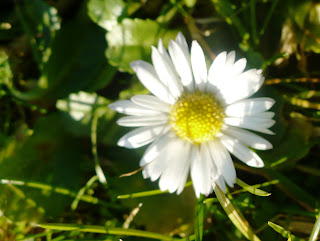Snowdrops (Galanthus nivalis), Witch-hazel (Hamamelis spp) and Dandelion (Taraxacum spp) were all in flower outside in the National Botanical Garden of Wales. Even the female flowers of regular Hazel (Corylus avellana) were glowing red. It was so cold, however, that the Mallards (Anas platyrhynchos) and Coots (Fulica atra) could only stand on the ice.
This blog may help people explore some of the 'hidden' issues involved in certain media treatments of environmental and scientific issues. Using personal digital images, it's also intended to emphasise seasonal (and other) changes in natural history of the Swansea (South Wales) area. The material should help participants in field-based modules and people generally interested in the natural world. The views are wholly those of the author.
Sunday, 30 January 2011
Friday, 28 January 2011
Seeing the Changes 343
In Westcross, the Garden crocus (Crocus sativus), Daisy (Bellis perennis) and Winter heliotrope (Petasites fragrans) were all in flower.
Monday, 24 January 2011
Seeing the Changes 342
Being in Kent, one gets a clear impression of how Spring gradually glides up our island from South to North. Snowdrops (Galanthus nivalis) and Winter heliotrope (Petasites fragrans) are both in flower here and the Hazel (Corylus avellana) has yellow catkins. I also found lots of hibernating Harlequin beetles (Acrocinus longimanus) in an old house where there were nightly visits by European badgers (Meles meles meles) and Red foxes (Vulpes vulpes).
Tuesday, 18 January 2011
Seeing the Changes 341
A frosty night, followed by a sunny day. In Bynea, spotted Grounsel (Senecio vulgaris) in flower as well as the first butterfly of the year. The latter turned out to be a Small tortoiseshell (Aglais urticae), no doubt awoken prematurely from hibernation.
Birder's Bonus 90
Yesterday, around a dozen Oystercatchers (Haematopus ostralegus) were feeding in the grassy area inside the University running track. There was a dead bird of prey (a Kestrel?) near the Singleton Park Boating Lake.
Sunday, 16 January 2011
Wood For the Trees
The news that the UK Government's selling off of Forestry Commission land has resulted in people being excluded from traditional walking areas, in spite of access being a specified criterion, is rather sad but predictable (http://www.ramblers.org.uk/forestrysales). Some collections of conifers (grown essentially as a 'crop') are rather boring but it is not a good idea to make it harder for people on this crowded island to walk in woodlands and to appreciate the natural world around them. It also appears that builders are taking an interest in some of the locations on offer. Increasing urbanisation is a serious issue for what remains of wild life.
Wednesday, 12 January 2011
Bunfight at the OK Coral
It has been suggested that environmental changes will lead to the extinction of many important coral species within the next 50 years (http://www.guardian.co.uk/environment/gallery/2011/jan/11/worlds-most-important-corals). This is a serious problem as much of the ocean's biodiversity is located within coral reefs (much of this life is of great economic importance- quite apart from being photogenic and a powerful ecotourism pull factor). In deed, it has also be claimed that reefs per se may cease to exist by 2100. Specifying in years is a way of generating an impactful headline (and perhaps generating funding) but it is not an exact science.
Monday, 10 January 2011
Enriching the Chickens
The European legislation that 'battery'/ high density chickens have to have 'enriched' caging from the beginning of 2011 is generating a lot of comment (http://www.guardian.co.uk/environment/2011/jan/09/egg-farmers-crisis-talks-europe ). The main concern expressed by UK farmers appears to be that the new caging is very expensive and they claim that, although they will adopt the new standards, competitors in some other EU countries may cheat to under-cut them on price. I personally feel that this is a difficult argument to maintain. Enrichment (a difficult term but one attempting to provide a more complex and naturalistic environment for the animals), done sensibly and based on science (rather than anthropocentric considerations) is a humane and appropriate action. You can hardly argue that it should not be done because others may not follow the legislation. That would really be chickening out!
Sunday, 9 January 2011
Friday, 7 January 2011
Left in the Larch!
The appearance of the 'Sudden Oak Death' disease in Larch in Somerset has led to 60,000 of these conifers being cut down in an area of about 2000 hectares in an effort to halt the spread of the pathogen (Phytophthora ramorum) (http://www.bbc.co.uk/news/uk-england-somerset-12134772 ). It seems that this fungus-like agent is rather unspecific about the kinds of trees that it infects. Larch are, of course, an important crop in managed woodlands.
Wednesday, 5 January 2011
Go West, Young Kittiwake!
A recent study has demonstrated that Kittiwakes (Rissa tridactyla) who successfully breed in the UK have dissipated the energy reserves they would need to make the winter migration to the USA or Canada (http://www.guardian.co.uk/environment/2011/jan/05/kittiwakes-wintering-breeding-success). Breeders simply sit out in the Atlantic. This is a nice demonstration of how energetics influences animal behaviour and how dependent they can be on 'trade-offs' (in this case procreation versus migration).
Tuesday, 4 January 2011
The Bee All and End All?
Disturbing news from the USA that 4 species of their 'common' Bumblebees have shown recent catastrophic reductions in both numbers (up to 96% in one case) and geographical distribution (http://www.guardian.co.uk/environment/2011/jan/03/bumblebees-study-us-decline?INTCMP=SRCH ). The species affected show a very high level of infection with the pathogen Nosema bombi (imported from Europe) but other factors such as the use of pesticides and changes in land management may be involved in the losses. These bees, along with hoverflies (also in decline), are incredibly important in the fertilisation of crop plants.
Monday, 3 January 2011
Bye-bye Blackbirds?
There is a strange story of around 2000 (American?) blackbirds falling dead from the sky over New Year in Beebee Arkansas USA (http://www.dailymail.co.uk/news/article-1343413/Thousands-blackbirds-literally-drop-dead-sky-Arkansas-city.html ). There is much speculation about what might have caused the fatalities (including lightening strikes and hail stones at altitude) but one suggestion is that they were scared to death by celebratory fireworks.
Saturday, 1 January 2011
Birder's Bonus 89
A sad start to the year in Loughor with a Redwing (Turdus iliacus) becoming a victim of traffic
whilst foraging.
whilst foraging.
Subscribe to:
Posts (Atom)
Planes and Trains and Old Folk
My trip home from Honolulu to Swansea simply cemented how difficult travel has now been made for the elderly (especially if they have a mobi...

-
It should hardly be called a study. A Which comparison looked at levels of nitrogen dioxide and small particulates (PM 2.5s) in 5 Londo...
-
Europe has a city congestion problem. In 2023, London was the most gridlocked location, closely followed by Paris and Dublin. In that year...
-
It's necessary, where possible, to replace diesel and petrol-fueled vehicles by electrical equivalents. Electric vehicles (EVs) don...




























